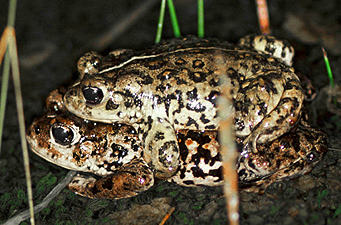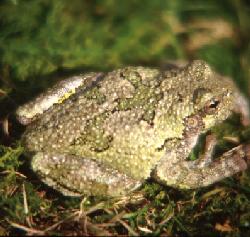

The term "survival of the fittest," which Charles Darwin adopted in later editions of his Origin of Species, remains an apt description of natural selection, as long as we understand what is meant by "fittest." We should forget the dog-eat-dog connotation, or (to quote Tennyson) "nature red in tooth and claw." Evolutionary fitness is measured in terms of reproductive success. This simply means that the genes of those who have the most offspring tend to beat out, in the long run, the genes of those who leave fewer offspring. This is natural selection at the genic level. By this selection of genes through generations, the gene pool (and the traits it produces) keeps changing. To contribute to that gene pool requires reproductive success, and natural selection is generally defined today as change in gene frequencies, or differential reproduction.
Enter the "selfish" gene, an idea popularized by the zoologist Richard Dawkins (in a book appropriately entitled The Selfish Gene). Genes of course can't be literally, consciously selfish, but it is a useful concept. For though we self-interested individuals die, a gene is potentially immortal--that is, the information contained in a piece of our DNA can be passed on indefinitely from generation to generation. So it is instructive to think of our genes as driving us into reproductive competition, with our disposable bodies being just temporary containers for these relentless little buggers. Our genes plan to be around, as it were, when we are long gone. In any case our innate desire for reproductive success--the one form of immortality we can be sure of (outside of religious faith)--explains why we creatures are intent on getting as many of our genes as possible into the gene pool and into future generations. The study of this reproductive drive and all its behavioral implications forms the basis of the new science called evolutionary psychology (EP).
This gene game of life, says EP, explains why males are by nature promiscuous, as one male can potentially sire hundreds, even thousands of offspring to advance the cause of his genes, whereas females are more sexually reserved, one female being able to conceive only a certain number of offspring in her lifetime. Thus a female by nature is more selective, wanting to find good male genes--to help her own genes' chances in the gene pool--for her numerically limited brood. Our selfish genes even explain why parents care for their young, for it makes perfect evolutionary sense to make sure that our young survive, to someday have young of their own, and so keep those precious genes going. Similarly it is genetically wise, from a selfish gene's point of view, to care more for our kin than for non-kin--the evolutionary phenomenon called kin selection--because our kin possess significant shares of the genes that we want to pass on.
Two recent animal studies entertainingly illustrate the biological drive for reproductive success. Consider the male western toad. Every spring the toads meet by the hundreds at particular spots for mating, and they have only a few days to get on with it. The scramble that ensues is complicated by the fact that the male toad can't distinguish one sex from the other. Consequently the male toad simply jumps on anything that moves. If he happens to jump on another male, birdlike sounds of protest from the latter quickly let the fool know. He simply turns loose and jumps on something else, until he finally, as we humans like to say, "gets lucky." The female doesn't protest, and the male toad might hold on for days.

As already noted, females in the animal kingdom, for a practical though unconscious reason, tend to be more selective than males in choosing a mate. (In evolutionary terms, this is sexual selection, a capacity that evolved by natural selection.) A study of gray tree frogs helps to illustrate this. Female tree frogs respond to male tree frogs who have longer mating calls; the females ignore the calls that are shorter. This type of behavior was once taken to mean that females simply tend to pick the more flamboyant males with no other redeeming qualities. But careful study of tree frog offspring has shown that the males with longer calls sire higher quality young, as measured by growth rate and such, than those with shorter calls. So somehow those longer calls are signs of good genes--and the females, far from just falling for show-offs as one might think, seem to know good genes when they hear them.

The western toad and the gray tree frog are of course but two of the millions of animal species, with their various evolved strategies of courtship and mating, that populate the planet. It is certainly fun to observe how EP, with the view of natural selection as differential reproduction, is reflected every day in animal behavior. A few more examples: male peacocks flamboyantly display vivid feathers to attract females ("look what good genes I have"); bright-billed male blackbirds and zebra finches attract more females than do those with duller bills; male barn swallows with darker breast feathers attract more females than do males with paler plumage; and male satin bowerbirds compete for females by decorating bowers to display, and by doing songs and dances.
It's pretty hard to deny that love (spelled s-e-x) makes the world go round.

Blount, Jonathan D., et al. 2003. "Carotenoid Modulation of Immune Function and Sexual Attractiveness in Zebra Finches." Science 300:125-127.
Coleman, Seth W., et al. 2004. ""Variable Female Preferences Drive Complex Male Behaviors." Nature 428:742-745.
Dawkins, Richard. 1989. The Selfish Gene. New Edition. New York: Oxford University Press.
Faivre, Bruno, et al. 2003. "Immune Activation Rapidly Mirrored in a Secondary Sexual Trait." Science 300:103.
Milius, Susan. 1998. "Toads Can't Tell Guys from Gals." Science News 153:390.
Morell, Virginia. 2004. "Why Male Bowerbirds Decorate as Well as Dance." Science 304:372.
Pennisi, Elizabeth. 1998. "Females Pick Good Genes in Frogs, Flies." Science 280:1837-1838.
Perkins, Sid. 2005. "Looks Matter." Science News 168:211-212.
Safran, R.J., et al. 2005. "Dynamic Paternity Allocation as a Function of Male Plumage Color in Barn Swallows." Science 309:2210-2212.
Wright, Robert. 1994. The Moral Animal: The New Science of Evolutionary Psychology. New York: Pantheon.

Copyright 1998, 2007 by Ronald L. Ecker
Contact:
hobrad at outlook dot com
dragonswood at comcast dot net
Back to Top | Acre | The Ron Ecker Home Page